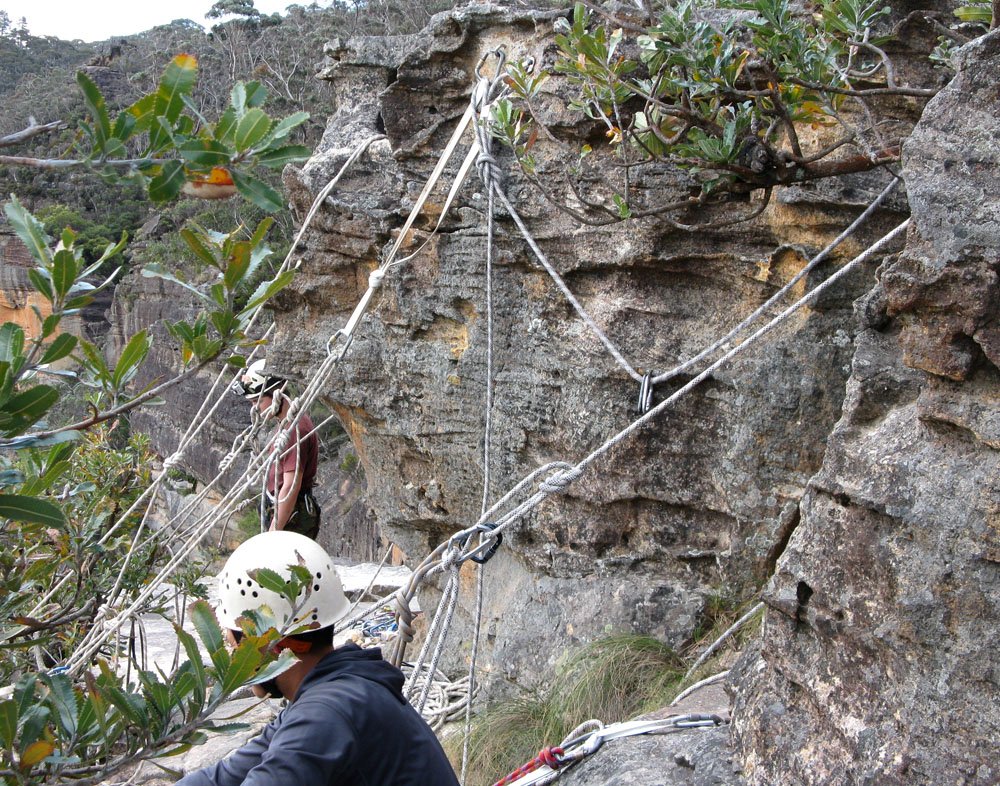I shouldn’t be here right now. I should be somewhere along an overgrown track in Nattai National Park, but I’m home because I seem to have buggared myself up. Years and years ago, when I was 28 in fact, which is so long ago I can barely remember it, Doug and I paddled a double sea kayak around the Western Province of the Solomon Islands. The local people spoke – at least to us – a version of English called pidgin English, and the expression we loved most of all, was “she (or he – Solomon Islanders are open about gender) go ‘buggar up.’” Many things went buggar up around the islands, including, somewhat troublingly, aeroplanes and boats. Right now, my leg and hip have gone buggar up. It’s likely some soft tissue injury, which is both good and bad. Good to know my bones haven’t crumbled, bad because soft tissue injuries take so long to heal and are so prone to becoming chronic.
We were climbing at Nowra, during school holidays! I underlined that as we usually avoid school holidays but we have had so much rain lately that our climbing trips had been delayed and when good weather arrived I was keen to get out. There was a crowd, an ever-changing crowd, the likes of which I have not seen since we used to climb in Canada and the USA. People came, climbed a pitch or two, left or moved on. Doug and I stayed where we were and simply moved along the routes. We both like this, it’s efficient and you get lots of climbing in. We also frequently climb the routes twice. Back in the day, people used to do this quite often, in fact people often used to down-climb routes. Down-climbing, like trad climbing, is a bit of a forgotten skill but can be really handy if you need to retreat off a route. Doug once down-climbed an entire route in Joshua Tree from the very top removing his gear as he went! It was impressive. The reason we climbed routes twice, and continue to do so, was to perfect your movement after the first time up. It’s an old habit and, despite changing norms, a worthwhile habit. Sometimes old stuff works so well you don’t need to replace it with new stuff.
Any time a crag is crowded weird shit will be going on. Some of it feels slightly unsafe, some sketchy, some downright dodgy. A father and daughter were climbing, Dad leading and outweighing the daughter by about 40 kilograms, with daughter belaying with an ATC. We are in an age where you expect everyone sport climbing to have a gri-gri or similar assisted braking device but ATC’s, like hexes, still float around the Australian climbing scene. Dad admitted to being slightly sketched on a couple of routes “What,” I pondered “would happen if Dad took a lead fall?” Things might go buggar up.
A few adults with a few dogs and children were belaying the children on two routes separated by a route in between. They had only one rope, so one end of the rope went up to a bell-ringer belay through one set of anchors, while the other end of the rope did the same to a second set of anchors a couple of metres away. The rope was too short for both child-climbers to be on the ground at the same time. So one child would climb up until the short end of the rope on the second climb had extended far enough to tie the other child in to start climbing. Then both children would climb with separate adults belaying them. If one child wanted to come down, they could only reach the ground if the second child climbed high enough to allow the rope to reach the ground.
An inventive use of one rope or potentially open to something dodgy or even a situation where everything went buggar up? Both climbers were light, the rope was used in a top-rope scenario only so not a lot of force on the rope (force = mass x acceleration, both low in this instance), but what happens if both children are unable to proceed up the different climbs and want to come down at the same time? It was vaguely disquieting but, like most things we do, proceeded without catastrophe. Does that make it a good idea? I’m not sure because it’s not entirely clear cut. When not climbing, the children were happily engaged in the sort of improvised play – moving rocks about in the dirt – that children everywhere excel at, so there seemed no reason to have the children continually involved in climbing. In fact, the children were largely uninterested in climbing, the rocks and dirt appeared to hold more appeal. Is that vague disquiet a sign that this unconventional approach is dodgy, or simply a lack of familiarity with the situation? What would happen if it all went buggar up?
In complex situations, and rock climbing, even in a top-rope situation is complex, I often think the best thing to do is revert to the simplest possible solution. In the above instance: one rope, one belayer, one anchor, one climber. Simple allows everyone to see at a glance that the basic tenets of safety have been attained and does not require complex thinking each time the climber switches out. This is why I find the increasingly complexity often displayed on social media sites (frequently canyoning for some reason?) worth ignoring. After all, no-one wants to find themselves in a situation where everything has gone buggar up.





No comments:
Post a Comment